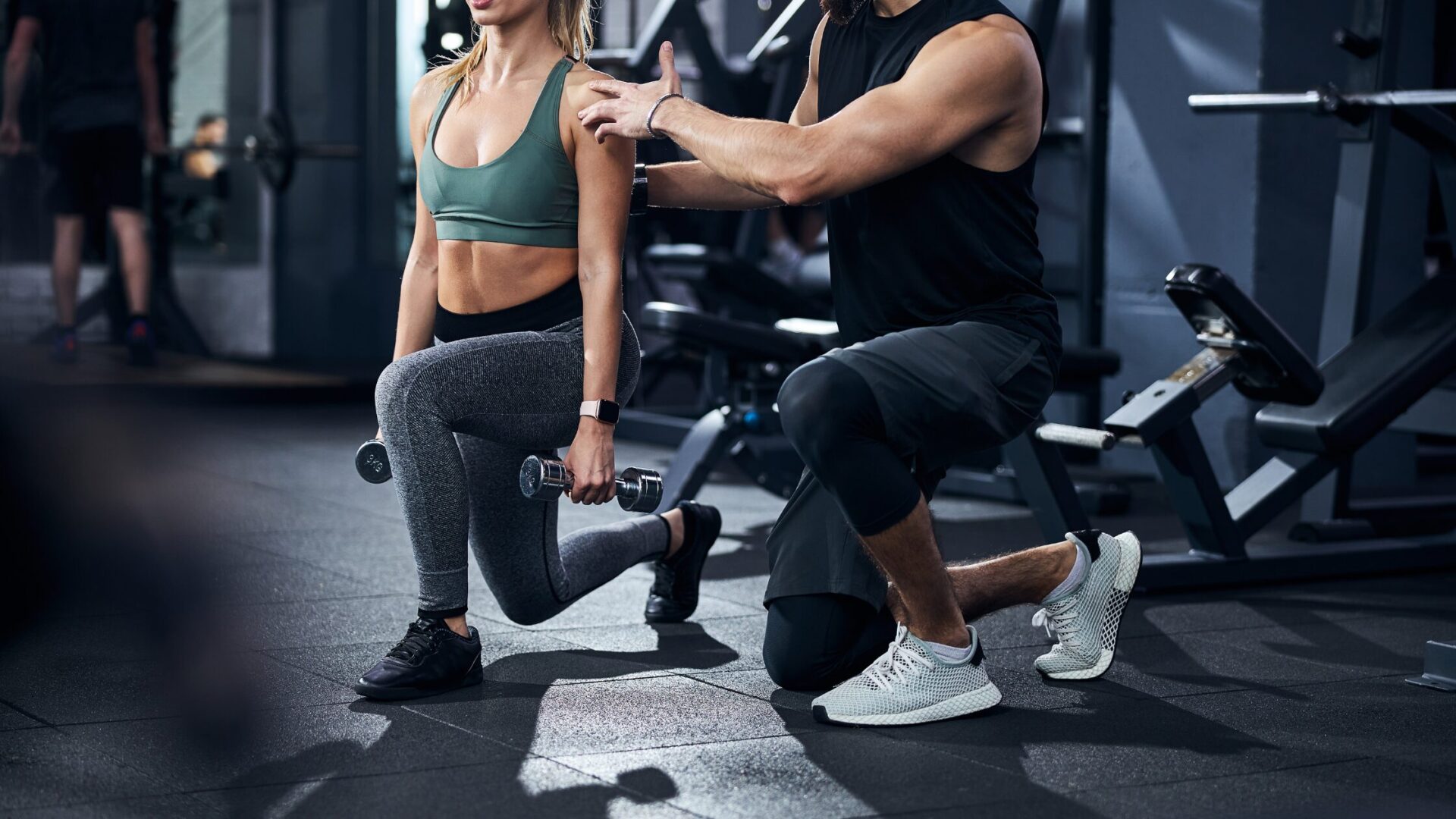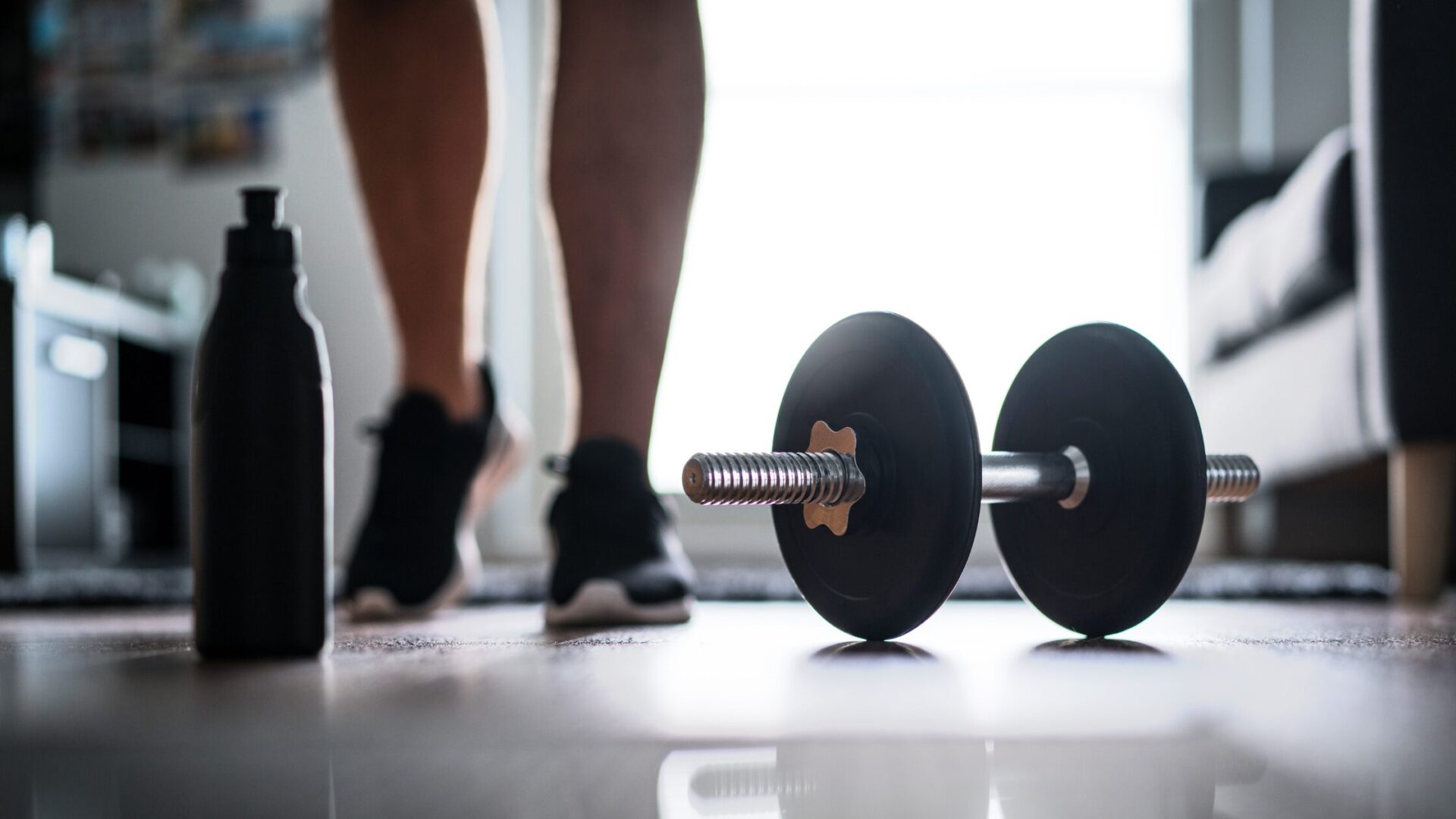Top 10 Exercises to Improve Posture In 2024
Introduction
Good posture is more than just standing tall; it’s an important aspect of our overall health and well-being. It contributes to reduced back pain, improved breathing, and a more confident appearance. Maintaining a proper alignment of the body not only prevents strain on your muscles and ligaments but also ensures that your bones are correctly positioned, minimizing the likelihood of joint and back discomfort. Additionally, a good posture allows for greater lung capacity, thereby enhancing oxygen flow to your muscles and brain, resulting in increased energy levels. Regular exercise strengthens the core and back muscles, providing the necessary support for a healthy posture. Below, we will explore top exercises that are specifically effective in nurturing and maintaining an ideal posture.
The Importance of Good Posture

Having good posture is not merely about aesthetics; it has profound implications for our daily life. Here are some key benefits:
● Enhances Spinal Health:
A straight spine is the backbone of good posture, potentially reducing the risk of spinal diseases like herniated discs.
● Improves Breathing:
Proper posture allows the diaphragm and lungs to expand fully, facilitating deeper, more efficient breathing.
● Increases Concentration and Thinking Ability:
Better oxygen supply to the brain boosts cognitive function and concentration levels.
● Boosts Energy Levels:
Proper alignment of the body helps in efficient muscular function, reducing fatigue and increasing energy.
● Decreases Wear and Tear on Joints:
Maintaining good posture reduces abnormal wearing of joint surfaces, which can lead to arthritis.
● Improves Circulation and Digestion:
Sitting or standing straight allows for better blood flow and organ function, notably benefiting the digestive system.
● Reduces Pain and Tension:
Good posture prevents muscle overuse and decreases the likelihood of neck and back pain.
● Enhances Confidence and Body Image:
Postural alignment can significantly improve an individual’s appearance and self-perception.
● Improves Core Strength:
Strong core muscles are vital for a good posture, providing stability and balance in every movement.
● Benefits for Social and Professional Life:
A good posture can convey confidence and professionalism, impacting interpersonal communication positively.
Common Posture Problems and Their Causes

Maintaining proper posture can be challenging, especially considering the various daily activities and lifestyle habits that contribute to poor posture. Here are some common posture-related issues and their underlying causes:
Sedentary Lifestyle
● Slouching in Chair: Prolonged periods sitting at a desk lead to slouching, which strains the cervical vertebrae and leads to imbalances.
● Forward Head Posture: Excessive screen time can cause the head to lean forward, increasing stress on the neck and spine.
● Lower Crossed Syndrome: Sitting for long durations may result in weak abdominal muscles and tight hip flexors, causing an arch in the lower back.
Poor Ergonomics
● Inadequate Workstation Setup: Computer screens that are too high or too low, or chairs that don’t support the back properly, can all contribute to poor posture.
● Improper Footwear: Shoes that lack support or give an uneven walking platform can disrupt the alignment of the entire body.
● Lack of Proper Equipment: The absence of ergonomic aids such as wrist rests or standing desks can lead to musculoskeletal issues.
Physical Factors
● Muscle Weakness: Weakness in the core and back muscles can lead to a lack of proper support for the spine.
● Uneven Shoulders: An imbalance in muscle strength or flexibility can cause one shoulder to be higher than the other.
● Obesity: Carrying excess weight, especially around the midsection, can pull the pelvis forward and strain the back.
Psychological Factors
● Stress and Anxiety: Tension can lead to tightened muscles, particularly in the neck and shoulders, resulting in poor posture.
● Low Self-Esteem: Individuals with low self-confidence might adopt a slouched, less assertive posture.
Habitual Factors
● Habitual Slouching: Continual slouching can become a habit that is difficult to break even when standing or walking.
● Overuse of Mobile Devices: Tilting the head down to look at phones or tablets can lead to “text neck,” an increasingly common postural syndrome.
Addressing these common problems often requires a multi-faceted approach, including adjustments to lifestyle, ergonomics, and physical conditioning.
Top 10 Exercises to Improve Posture
Before we dive into the specifics, please note that every individual’s body is different. It is important to consult a healthcare professional before beginning any new exercise routine, especially if you have existing health conditions or concerns.
1. Child’s Pose
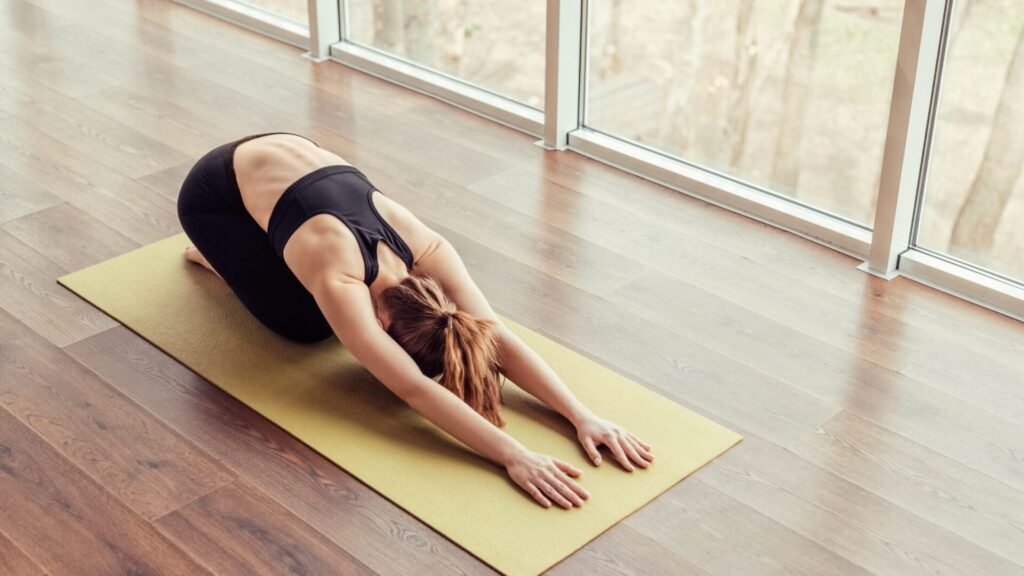
Purpose: To stretch and release tension in the spine, shoulders, and neck.
1. Start on your hands and knees, knees hip-width apart and hands shoulder-width apart. 2. Sit your hips back onto your heels, reaching your arms forward on the floor. 3. Lower your forehead to the ground, resting it gently.
4. Hold for 30 seconds to 1 minute, breathing deeply and allowing the spine to lengthen.
2. Cat-Cow Stretch
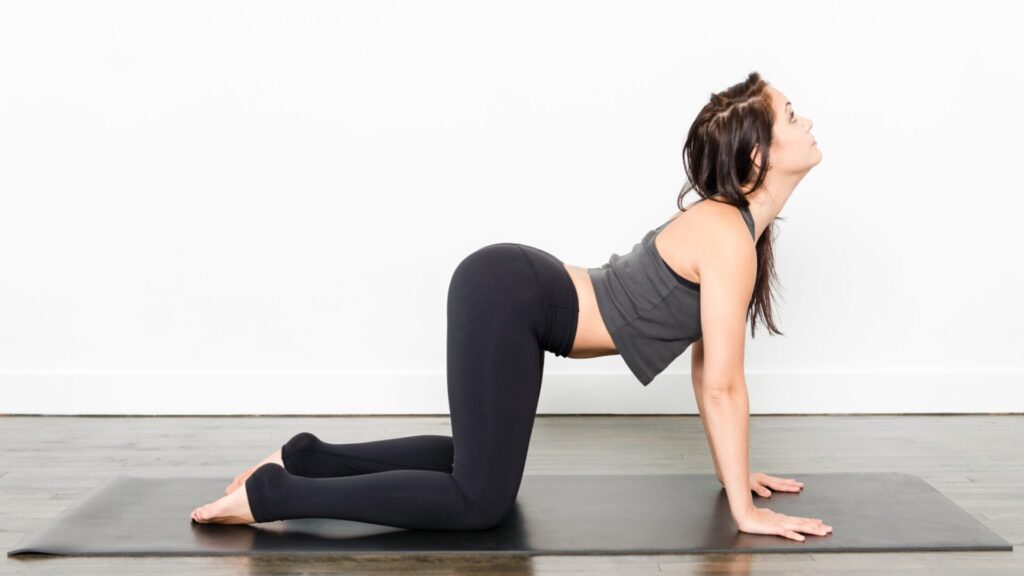
Purpose: To improve the flexibility of the spine and neck.
1. Begin on your hands and knees with your wrists directly under your shoulders and knees under your hips.
2. Inhale as you drop your belly towards the mat, lifting your chin and chest, and gaze up toward the ceiling (Cow).
3. Exhale, drawing your belly to your spine and rounding your back toward the ceiling like a cat stretching.
4. Continue this movement for at least 1 minute, moving with each breath.
3. Thoracic Extension

Purpose: To strengthen the upper back muscles and improve mid-back mobility.
1. Sit up straight in a chair with your feet flat on the ground.
2. Place your hands behind your head with your elbows wide.
3. Gently arch backward, focusing on extending through the upper and middle back. 4. Hold for a count of 5, then return to the starting position.
5. Repeat for 10-12 reps.
4. Plank

Purpose: To strengthen the core, shoulders, and back.
1. Lie face down on the floor with your elbows under your shoulders and hands flat on the floor.
2. Push up onto your toes and elbows, keeping your body in a straight line from shoulders to heels.
3. Engage your core muscles and hold this position for 20-30 seconds, building up to longer as you gain strength.
4. Rest and repeat 2-3 times.
5. Chest Stretch
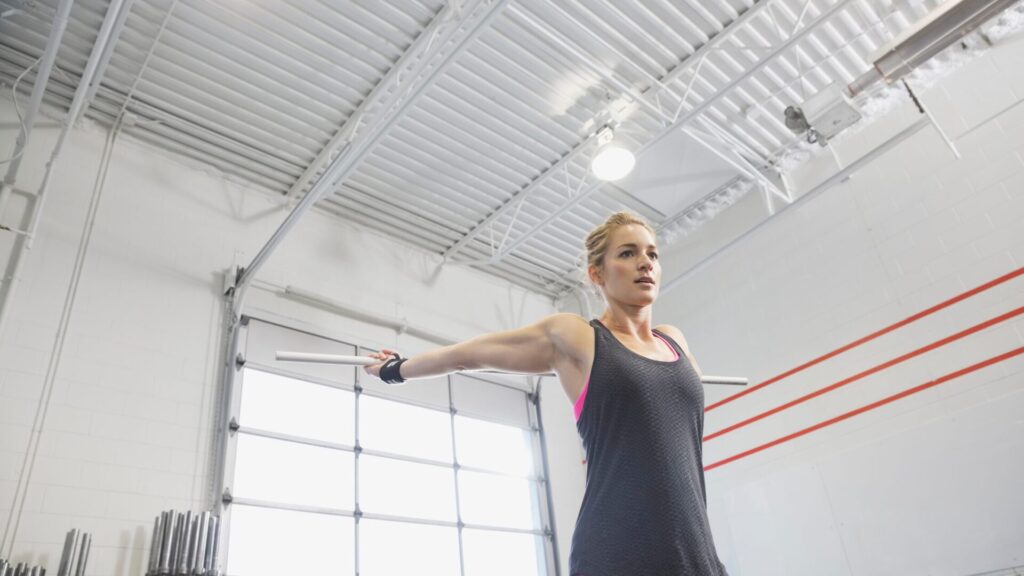
Purpose: To stretch tight chest muscles that can pull the shoulders forward.
1. Stand in a doorway, lifting your arm so it’s parallel to the floor and bending at the elbow to form a 90-degree angle.
2. Place your forearm against the door frame.
3. Gently lean forward until you feel a stretch in the front of your shoulder and chest. 4. Hold for 30 seconds, then switch sides.
6. Wall Angels

Purpose: To improve shoulder mobility and strengthen the muscles of the upper back.
1. Stand with your back flat against a wall, feet about four inches away from the base. 2. Press your arms against the wall with elbows bent at 90 degrees as if you are making a “W”.
3. Slowly slide your arms up to form a “Y”, keeping contact with the wall. 4. Slide back down to the “W” position.
5. Perform 10-15 repetitions for 2-3 sets.
7. Reverse Dumbbell Fly
Purpose: To strengthen the upper back and rear deltoids.
1. Stand with your feet shoulder-width apart, knees slightly bent, and hinge forward at the hips, keeping your back flat.
2. With a light dumbbell in each hand, extend your arms straight down with palms facing each other.
3. Raise both arms out to the side, maintaining a slight bend in your elbows. 4. Squeeze your shoulder blades together at the top of the movement.
5. Lower the weights slowly to the starting position.
6. Do 10-12 reps for 2-3 sets.
8. Seated Leg Extensions

Purpose: To strengthen the quads and improve pelvis positioning.
1. Sit on the edge of a chair with your back straight and feet flat on the floor. 2. Extend one leg out in front of you until it is parallel to the floor.
3. Flex your foot to engage the thigh muscles.
4. Hold for a few seconds, then lower your leg back down without resting it on the floor. 5. Repeat 10-15 times, then switch legs.
9. Hip Flexor Stretch

Purpose: To stretch and lengthen the hip flexors which can contribute to lower back pain when tight.
1. Kneel on your right knee, with your left foot in front, flat on the ground, creating a 90-degree angle at both knees.
2. Push your hips forward gently, keeping your back straight and not allowing your knee to go past your toes.
3. Raise your arms above your head and hold the stretch for 20-30 seconds. 4. Repeat on the other side.
10. Pilates Swimming
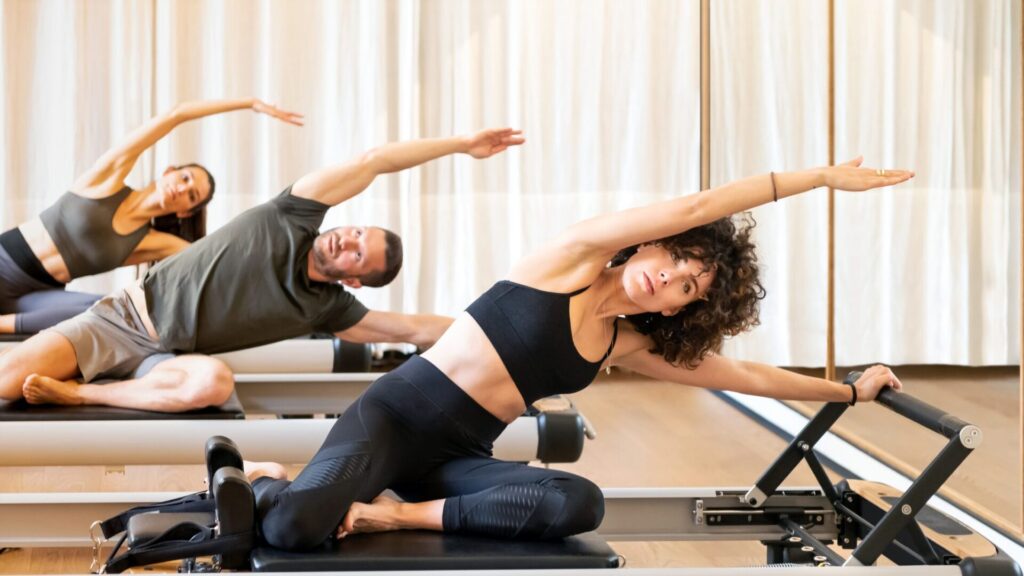
Purpose: To strengthen the back, glutes, and core muscles.
1. Lie on your stomach with your arms stretched out in front of you and legs extended. 2. Lift your arms, chest, and legs off the floor.
3. Alternate raising your opposite arm and leg higher, mimicking a swimming motion. 4. Keep your core engaged to protect your lower back.
5. Continue for 30 seconds, rest and repeat 2-3 times.
Incorporating these exercises into your routine can significantly contribute to better posture. Remember to perform each movement with attention to form and alignment to maximize their effectiveness in improving posture.
Tips for Maintaining Good Posture Throughout the Day
Maintaining good posture is just as important during your daily activities as it is during exercise. Here are some practical tips to help keep your posture in check throughout the day:
● While Sitting:
Choose a chair that supports your spinal curves and sit all the way back against it. Keep your feet on the floor or a footrest if they don’t reach. Avoid crossing your legs and keep your knees at or below hip level. Mayo Clinic provides excellent guidance on setting up an ergonomic workstation.
● While Standing:
Distribute your weight evenly on both feet and stand up straight with your shoulders back. Keeping your feet about shoulder-width apart can increase stability.
The American Chiropractic Association offers a detailed guide on proper standing posture.
● While Walking:
Hold your head high, pull your shoulders back, and engage your core. This not only helps with your posture but also makes your walk more efficient. Harvard Health Publishing shares the benefits of walking and how to incorporate it into your daily routine.
● During Phone Use:
Bring the phone up to eye level instead of tilting your head down. This simple change can prevent neck strain.
● While Driving:
Adjust the seat so that you can reach the pedals comfortably without straining and support your back fully against the seat.
Integrating these subtle changes can have a significant impact on your posture and overall health. Remember, good posture is a habit that requires conscious effort initially but pays off with numerous health benefits over time.
The Importance of Ergonomics in the Workplace
Understanding Ergonomics
Ergonomics is the scientific study concerned with designing and arranging things people use so that the people and things interact most efficiently and safely. In the context of the workplace, this means creating an environment that fits the individual’s needs, thereby reducing strain and preventing injuries.
Benefits of Ergonomic Solutions
● Reduced Risk of Injury: Properly designed workspaces can minimize the risk of repetitive strain injuries, which can occur from poorly arranged desks or chairs. ● Increased Productivity: When employees are comfortable, they can work more efficiently and with greater focus, leading to higher productivity levels.
● Enhanced Comfort: Ergonomic tools like chairs with proper lumbar support or adjustable desks can prevent discomfort and the negative effects it can have over time. ● Improved Employee Well-being: Attention to ergonomics shows that employers value their employees’ health and well-being, which can improve overall job satisfaction.
Remember that investing in ergonomics is not only beneficial for the individual but also for the organization as a whole. An ergonomic workplace is a proactive step towards a healthier, more engaged, and more productive workforce.
Building a Daily or Weekly Exercise Routine
Establishing a regular exercise routine is essential for reaping the long-term benefits of the posture-improving exercises listed above. Here’s how you can integrate them into your daily or weekly schedule:
● Create a Plan:
Start by mapping out your week. Choose specific days and times dedicated to your posture exercises, ensuring you can stick to them consistently.
● Set Realistic Goals:
Begin with short, manageable sessions. Even 10-15 minutes a day can make a difference. Gradually increase the duration and intensity as your strength improves.
● Routine Variety:
Mix different exercises each day to keep the routine engaging and cover a variety of muscle groups. This approach also prevents mental burnout and keeps the exercises challenging.
● Track Progress:
Use a journal or an app to track your routine and progress. This helps in maintaining motivation and allows you to adjust the routine as needed.
● Stay Consistent:
Consistency is key. Try to perform your exercises at the same time daily or on scheduled days to establish a solid habit.
● Listen to Your Body:
If you experience discomfort or pain, adjust the exercises accordingly or take a rest day. Your routine should build strength without causing injury.
Remember, integrating these exercises into a regular routine should not feel like a chore. Find a rhythm that works with your lifestyle and enjoy the journey towards improved posture and health.
Embracing Consistency in Your Posture Training
Consistency in your posture training regimen is the linchpin of success. Like any other habit, maintaining posture requires regular practice and mindful awareness. Embedding posture checks into your daily routine can gradually raise your proprioceptive sense, allowing you to naturally maintain correct alignment.
Advancing Gradually for Sustainable Improvement
As with any exercise program, a gradual progression in your posture exercises ensures long-term sustainability and helps prevent injury. Begin with simple, foundational movements and, as your muscles strengthen and your awareness increases, introduce more complex exercises. This steady approach not only fosters physical adaptation but also reinforces the psychological habit of maintaining good posture. Remember, incremental changes can lead to significant overall improvements over time.
Conclusion: Prioritizing Posture for Better Health
In summary, prioritizing good posture through daily exercises and ergonomic adjustments contributes significantly to overall health and well-being. Simple actions like maintaining proper
alignment while standing, walking, or using a phone can prevent long-term strain and injury. Creating an ergonomic workplace further supports proper posture, reducing the risk of repetitive injuries, enhancing comfort, and increasing productivity.
To fully benefit from good posture, it’s essential to integrate strengthening and conditioning exercises into a consistent daily or weekly routine. Begin with attainable goals and gradually build up your regimen, allowing for sustainable improvement without risking injury. Consistency is crucial in solidifying these habits, and gradual advancement ensures that your efforts yield lasting results.
We encourage you to take the first steps in embracing these practices, remembering that the path to better posture is a progressive one. By making these adjustments now, you set the foundation for a healthier future. Start incorporating these guidelines into your daily life, and witness the powerful impact it can have on your physical and mental health.

